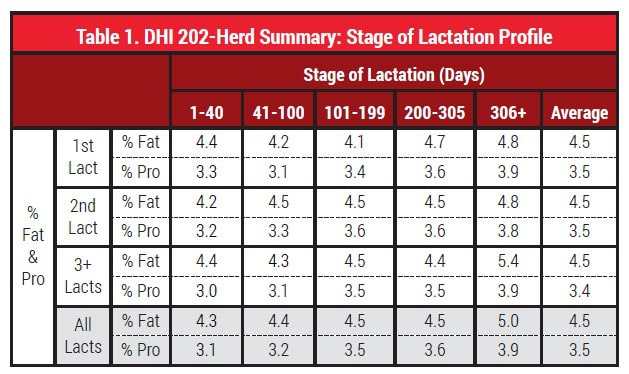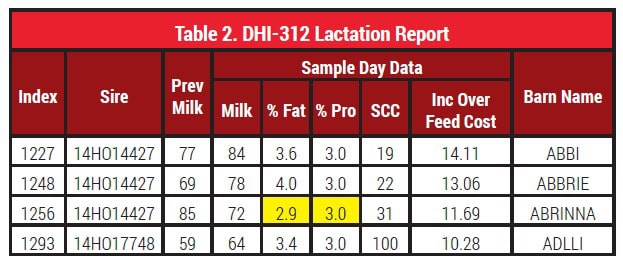Your DHI records are more than just numbers, they’re a roadmap for ration and herd management. Butterfat, protein, and the fat-to-protein ratio give early warnings when things aren’t balanced, letting you act before production or cow health suffers. By regularly reviewing DHI data, spotting trends, and taking action with your nutritionist, you can finetune rations, prevent metabolic issues, and keep your herd performing at its best. Key indicators to watch:
- Low milk fat may indicate inadequate effective fiber, too much rapidly fermentable starch, or rumen acidosis.
- Low milk protein can signal insufficient metabolizable protein, poor amino acid balance, or inadequate energy intake.
- Fat-to-protein inversion (fat below protein) is often an early sign of negative energy balance or subclinical acidosis, especially in early lactation.
These component patterns show up in your DHI data. Reviewing printed reports or custom reports you build in DART makes it easy to use your data. The 202-Herd Summary (Table 1) and 312-Lactation (Table 2) reports can help you see fat and protein trends, flag inversions, and identify cows or groups at risk. By reviewing DHI data regularly, you can detect early signs of nutritional or metabolic issues and take steps to keep rations and herd health on track.
- Identify cows or groups at risk by using component trends to flag inversions or abnormal values.
- Investigate rations and feeding practices by working with your nutritionist to check fiber, starch, protein sources, and energy density.
- Monitor cow health by testing fresh cows for ketosis, track body condition score, and watch for digestive upsets.
- Adjust feed management to keep feeding consistent, providing adequate bunk space, and mitigating heat stress.
- Track outcomes by watching patterns over weeks or months, not just a single test day, to confirm improvements.

The 202-Herd Summary Stage of Lactation Profile shows % fat and % protein side by side, making it easy to compare the two. Nutrition has a major impact on these values, and an abnormal fat-protein inversion can serve as an early warning of potential metabolic issues.

The 312-Lactation report flags cows with fat-to-protein inversions, making it easy to spot potential nutrition or metabolic issues early.
Supporting your DHI insights
As valuable as your DHI records are in helping to keep rations on point, they aren’t the sole solution. In my 11 years managing dairies, I found the most success in keeping production steady when I implemented protocols for continually checking forage dry matter. A Koster Test is a feed man’s best friend, doing this at least twice a week helps keep rations accurate and cows consistent, which shows up in DHI trends. TMR audits were another tool I initially found tedious but realized were invaluable. Every mixer is different: Are we overmixing or undermixing? What about particle length? Having the appropriate mixing time is crucial to maximizing production and ensuring DHI data reflects the ration accurately.
Another area that surprised me when I was managing herds was how little many of us know about our protein mix. I was just as guilty. We put a lot of trust in our nutritionists, and while that’s helpful, ignorance isn’t bliss. Today, when I ask producers if they have mycotoxins in their feed, they often say, “Yes, but the nutritionist has something in there to take care of that.” What is this “stuff”? Mold binders are the short answer, but do you know the feeding rate, the binder being used, or whether it’s effective? I’ve found that supporting the cow’s immune system through tools like DTX™ or BioCycle® Plus is the best recipe for gut health.
Feeding software is another valuable tool. It allows for precise ration balancing and better tracking of feed inventories. A nutritionist I respect once told me many people spend more time trying to shortcut the program instead of using it to its full capacity. Is this happening on your farm?
Daily practices
Even the best rations can’t perform if daily management isn’t consistent. How does the bunker or feed pile face look? I used to joke with employees that I cared more about the face of the pile than the one on my head. Truth is, that pile has a bigger ROI.
In the summer months, are you protecting TMR from excess heating? Are cows fed once or twice per day during the dog days of summer? Cleaning bunks daily is a simple but critical step, monitoring refusals and keeping feed fresh helps maintain intake and ensures your DHI numbers reflect actual nutrition, not feed spoilage or refusal.
Let DHI guide your decisions
When the herds I worked with were DHI testing, the butterfat and protein numbers were my personal report card. They showed whether cows were getting what they needed and if my management was consistent. Today, your DHI records can do the same for you. Use your DHI data, track trends, and let it guide your decisions, otherwise, you might be missing a key part of the picture.
Author: Tom Brown, CentralStar Genetic and Reproductive Consultant
